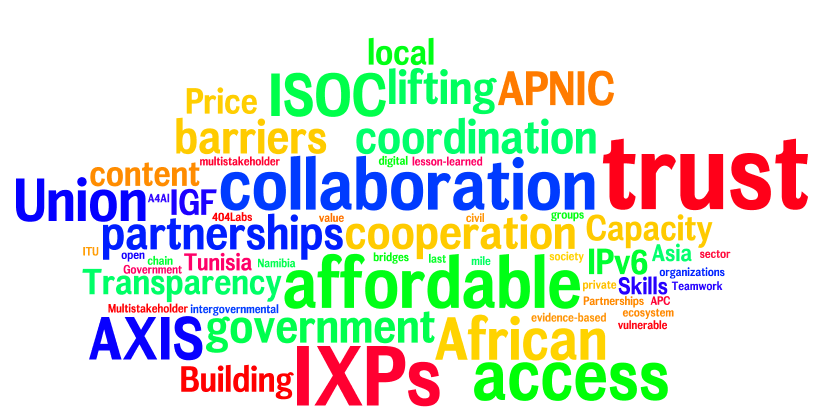We are firm believers that sustainable development – smart Internet development – is all about partnerships.
For more than two decades, the Internet Society has worked with partners to expand the Internet globally by facilitating Internet infrastructure development and-or convening communities of interest to build sustainable technical infrastructure and human and technical capacity development.
Our mission since 1992 is to help facilitate the development of a reliable and ubiquitous Internet, to train people, to build human capacity, and to encourage open dialogue among stakeholders about key Internet issues.
No one group does it alone – Internet communities don’t just light up once enough routers and switches have been turned on and people trained. Instead, these communities must be nurtured, and trust must be built among participants in order for SMART sustainable Internet development to be achieved.
We have found that everywhere the Internet has flourished, it has done so thanks to the existence of a robust technical class of engineers, technicians and users who ensure the network keeps running. It is about people. People who have worked with other experts to learn more, understand network architecture and traffic management, who have created local, regional, and international partnerships for development. They also create the tools, forums and services that create local demand. And, work together to convene stakeholders as we are doing today, in Geneva, under the WSIS+10 umbrella of meetings.
The World Summit on the Information Society (WSIS) recognized the importance of and Roles for Stakeholders
Paragraph 50 of the Tunis Agenda recognized the need for partnerships for building International Internet Connectivity (IIC). A variety of actors play different in facilitating and building infrastructure.
For example – Internet exchange points are a key part of IIC.
IXPs at the most basic level are switches, routers, ports, cables, and servers that allow local IP-based network providers (e.g., Internet service providers, national research and engineering networks, government networks, and mobile networks) to interconnect with each other and exchange traffic. In other words, network providers in a single country can share data traffic directly, instead of having to connect through an exchange point in a foreign country.
In theory at least, this means that any country that establishes an IXP, or improves the network of IXPs it has in place, will have faster and lower-cost Internet service. It often means that more of the population will be online, and more mobile operators, content companies and other network service providers will invest. IXPs keep local traffic local.
The great thing about IXPs is that all this can start from a pretty modest technical base. IXPs don’t have to be elaborate when they get going. The London Internet Exchange (LINX), to take one example, began in 1994 with a single donated piece of networking equipment and five local Internet Services Providers as members. Today, London has over 400 members and is one of the biggest IXPs in the world. LINX started with people working together to build something. Technology does not walk by itself and success relies on those partnerships that pull communities together.
The Internet Society and other organizations around the world (the African Union, APIX, Af-IX, Euro-IX, LAC-IX, LACNIC, Packet Clearing House) can help countries obtain equipment. The really important part is what comes next. At the Internet Society, we have seen plenty of countries plan to implement an IXP—including picking a location and accepting shipment of equipment—only to have the process stall. Why? Sometimes the community of interest has not come together or does not have enough technical bandwidth and participants are not fully invested in developing the IXP.
When things like this happen, it’s a reminder that the technical infrastructure—routers and switches—is only a part of Smart Internet Development, and not the most important. It cannot stand on its own.
Partnerships do stand on their own, and our panel at WSIS+10, today, brings a variety of stakeholders together to discuss the importance of partnerships for Internet development. Through the efforts of the organizations and people on this panel – Internet Community Partnerships for Development: Creating the Enabling Environment through Capacity and Infrastructure Development, and Related Economic Factors – a stronger more technically capable community of experts has been developed, better local networks have been built, local connectivity costs have come down, and human networks of trust have been developed.
If there is one shared theme across today’s panel and across the efforts of our panelists and their organizations – it’s that small-scale efforts can yield massive dividends.
As we mentioned at the beginning of this blog, no one organization does it alone. Partnerships create those critical human networks that sustain communities, bring in new technology, and keep building out and improving networks one partnership at a time.

